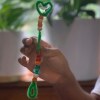Tapping Into Mindfulness Toolbox for the New School Year

As we approach a new school year with uncertain schedules, new roles, new expectations and unprecedented practices regarding health and safety, it is completely normal for both parents and children to feel anxious about the unknown. Creating a mindfulness toolbox for the family can be a great way to focus on the things we can control, teach children life-long coping skills, and build good self-care habits.
A mindfulness toolbox is a holistic way for adults and children to find peace, feel grounded, and connect to the present moment. The term toolbox may infer that there need to be external objects a person must have in order to obtain mindfulness. While a mindfulness toolbox can indeed be made up of physical items that promote peace and calmness, the main idea is to think of it as a combination of skills and resources you can tap into both internally and externally.
Even within the same family, no two toolboxes will look the same because what may be effective for one person may not be for another.
Mindfulness Toolbox: Internal and External Resources
Breathing
The ability to do breathing exercises is an essential mindfulness skill that should be the foundation of every toolbox. Connecting to the breath is the fastest way to check in with the mind and body and can be done anywhere and at any time. Bring attention to your breathing alone or with fun tools like a breathing wand or hoberman sphere for kids. Perhaps you may want to try breathing exercises by incorporating other external resources such as sitting on a meditation pillow or laying down on a yoga mat.
Identifying Emotions
Another mindfulness skill is being able to identify emotions and work through them. This can be done by talking, journaling or creating a gratitude list. For smaller kids, painting and drawing can be an effective way of expressing themselves.
Sensory Tools
A well-balanced toolbox may also include things that evoke our senses.
- Smell: Essential oil roll-ons and diffusers not only smell good, but are also great mood enhancers. Some essential oils have energy boosting properties while others have calming effects.
- Sight: Looking at a meditation jar is a wonderful visual resource and can be soothing for adults and children.
- Hearing: Hearing the sound of music, chimes, singing bowls, guided meditations or nature is also very effective for creating a sense of calm.
- Touch: For touch, grounding yourself in nature is a way of feeling connected to the earth at times when you may be feeling disconnected from yourself and others. If you are creating a physical space for your mindfulness toolbox, consider incorporating stress balls, blankets and eye pillows as well. These items feel good and promote a sense of security.
Making it Work
As you begin introducing the resources and practices that make up a mindfulness toolbox to your children, it’s important to have teachable moments with them. When children understand what they’re doing and why, it empowers them and makes it more likely that they will seek out the practices on their own when they need to. Children are also naturally curious, so if any of these practices are things you want to try or already may be incorporating into your self-care routine, invite them to join you. Encourage your children to have fun exploring different practices and resources to add to their mindfulness toolbox because such tools will be useful to them their whole lives.

